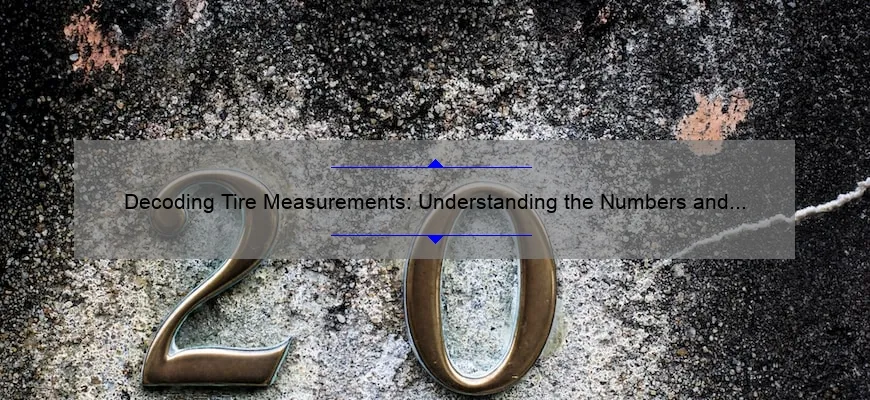Short answer what tire measurements mean:
Tire measurements include the width, aspect ratio, and rim diameter of a tire. The first number indicates the width in millimeters, while the second number represents the height as a percentage of the width. The third number is the rim size in inches that fits the tire.
Breaking Down the Basics: How to Interpret What Tire Measurements Mean
If you’re new to the world of cars, or you’ve always left tire maintenance and replacement to the mechanic, interpreting what those seemingly random numbers printed on your tires actually mean can be confusing. However, understanding how to read tire measurements is crucial for ensuring that you’re buying the right tires for your vehicle and maintaining them properly.
Tire measurements are generally displayed in three parts: width, aspect ratio, and rim diameter (e.g., P215/60R16). Here’s a breakdown of what each part means:
Width: The first number in the measurement refers to the width of the tire in millimeters from sidewall to sidewall when it’s mounted on a wheel. In our example above, a “P215” tire would measure 215 millimeters across its widest point.
Aspect ratio: The second number represents the aspect ratio – or profile height – of the tire compared with its section width. This is expressed as a percentage, so an aspect ratio of 60 means that this particular tire has a profile height equaling 60% of its width.
Rim diameter: Finally, following “R” which stands for radial construction method comes rim diameter where last two digits specifies required rim size measured in inches e.g., R16 means we need sixteen-inches steel/alloy rims for mounting these tires
In practice therefore if overall measurement was P215/60R16 it will have:
• Width (in mm) = 215
• Aspect Ratio= 0.6 x 215 = approx..129mm
• Rim Diameter(in inches)= specified as objective unit.
Some other markings could also appear like load index(for indicating maximum weight-carrying capacity), speed rating(Ranging from Q->99 mph / L->75 mph up-to Y ->186mph)
A specific abbreviation added might hint towards type(like M+S- Mud + Snow) makes things trickier for those unaware of the jargons. To interpret these measurements more effectively, take note of your car model and year to know if originally it came with certain type/size that must be used as reference before finalizing new purchase avoiding any kind of dependency on mechanic(hopefully reducing overall cost)
Not only does understanding tire sizes help you select the right tires for your vehicle but also helps in assessing reasons behind uneven wearing or baldness observed during inspections which could hint towards underlying mechanical issues like incorrect alignment , driving habits etc.
Thus interpreting matters when it comes to ensuring effective and safe transportation within reasonable budget leading all-around safety keeping the driver confident enough whilst enhancing comfortability.
A Step-by-Step Guide to Deciphering Tire Measurements
For many people, understanding the numbers and letters on their tires can be a daunting task. Tire measurements are vital to determining what kind of tire you need for your vehicle, as well as ensuring optimum safety and performance levels while driving. In this guide, we will break down each section of a tire measurement to help you decipher them easily.
Section 1: Tire Width
The first number in a tire measurement represents the width of the tire in millimeters from sidewall to sidewall when mounted on a wheel. For example, if your tires read “215/60R16,” then “215” is the width measurement. It’s essential to choose the appropriate size according to your manufacturer’s recommendations because too narrow or wide tires may cause problems such as decreased traction and premature wear.
Section 2: Aspect Ratio
The second number represents the aspect ratio-in percentage- between your tire‘s height and its width (sidewall). A lower aspect ratio often implies better handling at higher speeds, but it also means less comfort due to fewer shock-absorbing properties.
For instance, when dealing with our previous example (“215/60R16”), “60” is the aspect ratio of four-inch tall rubber doughnuts that separates 129mm away on either side of tread making up nearly half an inch since there are twenty-five-point-four millimeters per inch(lengthwise).
Section 3: Construction Type
This section illustrates how an unusual type might have been constructed inside out by releasing air pressure (reversing tread face) [self-supporting run-flat status] Like temporary spares instead have lesser load capacity ratings than traditional counterparts whose internal components strengthen pipes from board-to-tread during production( R=radial construction),in addition building both sides typically bore bias plies crisscrossed(sometimes X-Ply sometimes without zigzag pattern), which together form conventional cross-ply structures(B=bias belted style).
Section 4: Rim Diameter
The final number in the previous example (“215/60R16”) illustrates rim diameter measured from bead seating area to another, specifying correct fitment with wheel hub. In other words, it’s impossible to fit a sixteen-inch tire on a fifteen-inch rim without running into some difficulties.
Congratulations! You now have mastered reading tire size designations using examples mentioned.to get most out of wear or performance while driving. Always consult your owner’s manual for correct inflation pressure and consult with local mechanics if new set needed.
Frequently Asked Questions About What Tire Measurements Mean and Their Significance
As a driver and car enthusiast, tire measurements can be something of an enigma. What do all those numbers mean? How important are they to the safety and performance of your vehicle? In this FAQ guide, we’ll take a detailed look at what all those tire measurements represent and why they matter.
1. What do the numbers on my tires mean?
Tire measurements indicate certain information about your tire including its width, aspect ratio (the height of the sidewall in relation to its width), construction type (radial or bias-ply), rim diameter (the size of wheel it fits on) and load index/ speed rating which indicates how much weight a tire can carry safely as well as the maximum speed it is capable of traveling without failure.
2. Why is it important to know these measurements?
It’s essential that you choose tires for your vehicle with correct specifications otherwise performance issues could threaten road handling due to incorrect match between wheels,rims,tires etc resulting in danger . Choosing wrong specification may also have legal consequences hence most manufacturers include recommended sizesin manuals or in some cases like Sports cars manufacturer recommend one specific make/model thus assuring optimum control & Safety
3. How do I find out what size my tires should be?
Your vehicle owner’s manual will provide exact recommendations for fitment but if here missing another method would be checking existing worn tyres Thiswill show their current specifications ie:The tyre marking 205/60 R16 90V explains:
– Width =205mm;
– Aspect Ratio=Height divided by variation width expressed as percentage so:60% indicating direction from base
– Radial Construction referred by letter ‘ R’
– Rim Diameter indicated after / markie :Rim Diagonal = 16”
– Load index and Speed Rating :its max weight carrying capability and top speed respectively , V denotes highest permissible speeds upto 149mph
With above details determine whether you need same spec replacementor upgrade require some adjustments to enhance vehicle performance
4. What is the significance of tire size?
Your tires are key components in your car’s overall handling and safety. Proper fitment affects how well your car corners, accelerates or brakes for optimum control on road This also leads to better fuel economy, helps prevent premature wear and reduces the risk of unsafe driving conditions.
5. Should I ever change my tire size from what the manufacturer recommends?
Generally it’s not advised unless recommended by manufacturer if you want different driving feel based with trade off with lower relaibility . Replacing a tyrewith unsuitable specification may affect odometer & speedometer accuracy which can leadto erroneous readings causing excessive mileage recorded affecting resale value thus always best to stick with manufacturers recommendations
6. Can I use a wider tire than what my rim is specified for?
It’s advisable generally not too due potential danger caused by incorrect torque settings straining wheel bearings ,susceptible braking distance modifications etc all leading reduced level of safety It could be possible sometime that In few specific sports cars case manufacturers recommend an increase however never take such risks without being instructedby authorized persons as it may simply result in accidents
In conclusion knowing facts around tyre selection or understanding changing specifications involving many options meansweighing various competing factors ie :Performance gains beyond existing specifics may be offset redundant detrimental effects thereby risking safety& long term expenses hence need proper care recommendation alignment by authorised personnelle after purchase ensuring smooth controllable ride throughoutvehicle life positively impact running cost over longer tenure
Top 5 Essential Facts You Need to Know About What Tire Measurements Mean
As our vehicles continue to evolve with technology and advancements, it is not uncommon for the average person to find tire measurements confusing and overwhelming. However, understanding the key factors of what tire measurements mean can be crucial for your safety on the road. Here are five essential facts that you need to know about tire measurements.
1) Tire Size Matters:
The size of each tyre is an important factor in determining how well your vehicle can handle different conditions while driving. Smaller sized tyres will have a shorter turning radius compared to larger sizes which offer more grip on wet surfaces as they cover a greater surface area when in contact with the ground.
2) Understanding Tire Width:
Tire width simply tells us how wide a particular tyre model is from one side wall edge to another. It typically ranges from around 175mm up into 315mm – all dependent upon manufacturer various models and products.
3) Aspect Ratio Considerations:
Aspect ratio indicates how tall a tyre sidewall measures by reflecting its respective height along its entire circumference relative to its own width at tread level measurement point across extra care must be given if being choosing new wheels or tyres as changes may result in handling differences whilst driving once mounted onto your vehicle’s alloys
4) Load Capacity & Speed Ratings Matter Too!
Ensuring that every autos’ tyres supports maximum weight load based off their per wheel ratings (listed N.t.o.A.,for replacements!). Every automaker assigns specific qualifications needed depending application types These determine whether safely maintain speeds over certain limits set within range class grouped together speed rating categories Refrain from trying anything less: Accidents involving overloaded carrying capacities prove catastrophic accidents similar to those using lesser-rated versions originating overseas manufacturers situated mere feet away harmful debris travelling straight through thin compound rubbers!
5) The Importance of Proper Inflation:
Correctly filling air pressures required out most importantly awareness concerning decreased pressure levels below minimums recommended by manufacturing-bond assembly protocols offered as driver-assistance protocol your particular vehicle in question can increase risks altering proper handling characteristics beyond control, leading to unavoidable damage caused by accumulated failures often perceived as common occurrences amongst those unaware.
In Summary
Understanding tire measurements and how they impact the way our vehicles handle on the road is of utmost importance for our safety. Tire size, width, aspect ratio consideration are just a few things meaning there’s more criteria to take into account like Load Capacity & Speed Ratings along with Importance of Proper Inflation cannot be neglected as it ensures optimum performance while driving travel all distances whether short jaunts or long adventures await!








